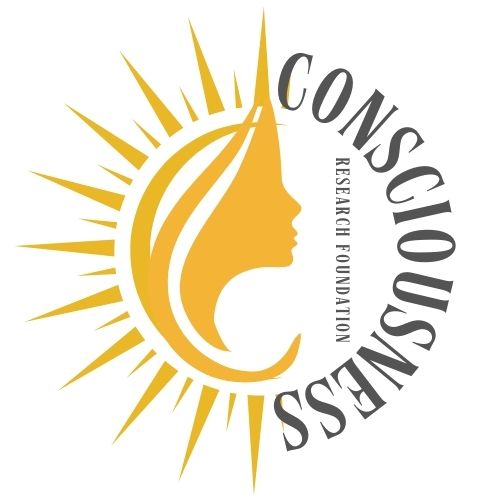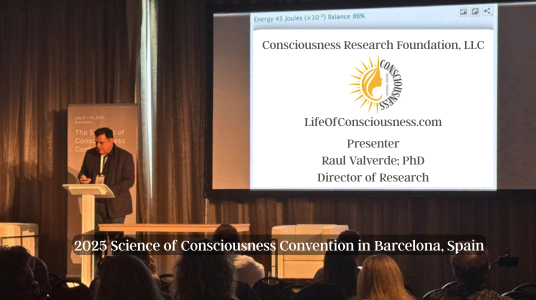


Consciousness Research Foundation had the honor to present at The Science of
Consciousness
Conference On July 6 — 11, 2025
in Barcelona, Spain
To review the presentation select the PDF presentation button below to dowload and view.
Presentation Research on Medical biometrics based on Gas Discharge. Visualization technology approach to survival research: A case study.
Client Research & Projects
Consulting with Igniton Corporation for the research and development of the IgniCognition that is a supplement for improved memory, focus, and mental speed and IgniLongevity that is a supplement to reprogram body’s response to occasional stress and aging.
Biophotonics & Electrophotonic (GDV/EPI) Research Services
Non-invasive optical and electrophotonic measurements to explore physiology, personality test, stress, and wellness—purpose-built for natural medicine and psychology research.
What we do
We design and run IRB-friendly pilot and full-scale studies that combine biophotonic ultra-weak photon emission (UPE) imaging with optional GDV/EPI measures to investigate oxidative-stress dynamics, psycho-physiological states, personality tests, and responses to integrative interventions (e.g., breathwork, mindfulness, manual therapies). Results are delivered with transparent methods, effect-size estimates, and publication-ready figures.
Services
For Natural & Integrative Medicine
UPE/biophotonic assessments to quantify skin oxidative-stress patterns before/after interventions.
Longitudinal wellness tracking with pre-registered outcomes and standardized lighting/imaging protocols.
Exploratory GDV/EPI add-ons for hypothesis generation around autonomic balance and energy-state proxies (research-use only; not diagnostic).
For Psychology & Psychophysiology
Multi-modal study builds that align UPE or GDV/EPI signals with EDA/HRV/EEG and validated scales (e.g., stress, affect).
Intervention response analysis (e.g., massage, meditation, breath training) with pre/post effect estimates and mixed-models.
Personality testing that aligns with MBTI types
Methods (plain-language, evidence-aware)
Biophotonics (UPE imaging). We capture ultra-weak photons emitted by skin that reflect oxidative processes; imaging can map regional differences and track changes over time in a fully non-invasive manner. Used strictly for research, it has shown utility for evaluating oxidative stress in vivo.
Gas-Discharge Visualization (GDV/EPI). We can optionally record electrophotonic “corona-discharge” patterns around fingertips using high-voltage, short-pulse stimulation. GDV/EPI has been explored in medical biometrics and psychophysiology, but findings are mixed; we treat it as exploratory research instrumentation, not a diagnostic test.
Deliverables
Study design & protocol (sampling, controls, blinding where applicable).
Data collection & QA (lighting control, dark-adaptation, electrode safety).
Analysis & visualization (pre-registered models, effect sizes, reproducible code).
Technical report suitable for journals/boards and stakeholder decision-making.
Software development for the integration of GDV technology into other systems
Video Presentation by Raul Valverde; PhD
on Google Scholar
Our Research
Bio Metrics Based on Gas Discharge
In this study, we use GDV technology to measure personality before and after death under the assumption that bioenergy fields are still linked to the body after death.
Preliminary results show the potential of this technology to prove the survival of personality hypothesis. The objective of the research is to propose a new framework for understanding human consciousness by using a novel approach to survival research with the use of GDV technology, bio energy models and quantum theories of human consciousness.
Medical biometrics based on the gas discharge visualization (GDV) technique is used in medicine to monitor patients and compare their natural electro-photonic emission before and after surgeries, cancer treatments, energy healing and physiotherapy. Previous findings using GDV have shown that it can monitor a transition from a disease state to a normal functional state. GDV is based on electrical activity in the human body. The GDV is based on the bioenergy model, which is compatible with the Penrose-Hameroff 'Orch OR' model.
Bio-Well is the GDV technology used in the study. The Bio-Well device uses GDV to measure and analyze electro-photonic emissions of the human fingers.
When a scan is conducted, a weak electrical current is applied to the fingertips for less than a millisecond. The skin’s response to this stimulus is the formation of a variation of an “electron cloud” composed of light energy photons. The electronic “glow” of this discharge, which is invisible to the human eye, is captured by the camera system and then transmitted and translated back in graphical representations to show energy, stress and vitality evaluations. Bio-Well illustrates the overall state of a person’s energy field. The images created using the Bio-Well system are based on the meridian system.
The "Survival Hypothesis" asserts that a person's personality and consciousness survive the physical death of the body. This research aims to use GDV to identify the psychoemotional functions of a person using fingertips. These psychoemotional functions are linked to the personality of the individual. The research presents an interrelationship between human psychology and the bionenergy model, and how it aligns with the Myers-Briggs Type Indicator (MBTI) personality traits that is a framework to analyze human personalities.
As part of this study, we measure the personality of research participants by measuring the psychoemotional functions using GDV before death. We then measure these psychoemotional functions after death and compare them to test the survival of personality hypothesis. The research employs a novel approach to survival research by using the energies proposed by the bioenergy model instead of the traditional approach of using EEGs to analyze brainwaves. The bioenergy model shows that nonlocal consciousness is connected to the body through bioenergy fields that can be measured in the physical body using GDV technology.
When the body dies, these bioenergy fields remain connected to the body for a period that is still unknown. In a 2014 experiment conducted by Dr. Korotkov with GDV technology on people who had died, the observed levels of energy reduced over time and their patterns were related to type of death they had suggesting that this measured energy captures the consciousness of the dead individual. This research results suggests that the hypothesis that the non-local consciousness remains linked to the physical body several days after death is true.
In this study, we use GDV technology to measure personality before and after death under the assumption that bioenergy fields are still linked to the body after dead.
Preliminary results show the potential of this technology to prove the survival of personality hypothesis. The objective of the research is to propose a new framework for understanding human consciousness by using a novel approach to survival research with the use of GDV technology, bio energy models and quantum theories of human consciousness.
Jennifer Hamilton: RN, BSN offers an introductory video to help you understand Consciousness Research Foundation.
Your participation can give us additional evidence.
Raul
Valverde; PhD
Director of Research
Konstantine Korotkov; PhD
Consultant
Jennifer
Hamilton; RN, BSN
Death Midwife
Chet
Swanson: MS
President
